#participatory citizen
Text
WEEK 10: DIGITAL CITIZENSHIP AND CONFLICT: SOCIAL MEDIA GOVERNANCE
This piece of writing will discuss online harassment, with a focus on how to best solve and deal with the issue.
WHAT IS ONLINE HARASSMENT?
Jones et al. (2013, p. 54, as cited in Haslop et al., 2021, p. 1420) define online harassment as the behaviors that are unwanted and offensive targeting directly at other people through modern technology channels, for instance, the internet. Online harassment can exist in various forms, for example: directly sending abuse messages, sexual images, spreading rumors, and so forth (Haslop et al., 2021, p. 1420).
THE REALTITY
According to Pew Research Centre & Southern and Harmer (2017; 2019, as cited in Haslop et al., 2021, p. 1420), online harassment is more likely to happen to women than men. A YouGov survey, including 2121 women and 1738 male participants, reports that sexual images have been sent to 40% of women participating in the survey without their requests, while only 26% of male participants have been sent those images (Smith 2018, as cited in Haslop et al., 2021, p. 1420). This phenomenon can be explained through the “nature” of online space, which is now considered a “public space”, where if women want to ensure their safety, they must exclude their presence from the space (Vitis & Gilmour, 2016, p. 339). Furthermore, Keraian & Megarry (2014; 2014, as cited in Vitis & Gilmour, 2016, p. 339) add that once women choose to participate in the digital space, they must take harassment and attack as an apparent and normal experience.
THE CONSEQUENCES
Being harassed online, numerous women chose to censor themselves to minimize the risk of further online harassment in the future (Lenhart et al., 2016, as cited in Haslop et al., 2021, p. 1421). Others change their names in the online world, reduce their time appearing online, become more selective in choosing what online site to use, or even shut down every online account (Gumbus & Meglich, 2013, p. 48; Franks, 2012, as cited in Vitis & Gilmour, 2016, p. 339). The “nature” of the online space causes these negative consequences, leading to demotivation and a decrease in women's engagement with online sites (Haslop et al., 2021, p. 1421).
HOW SOCIAL MEDIA PLATFORMS, AS ONLINE PLATFORMS, HELP FIGHT AGAINST ONLINE HARASSMENT?
Meta’s social media platforms, including Facebook, Instagram, and Messenger, and TikTok are now putting a lot of effort into controlling and preventing online harassment. Meta has used many strategies to control and prevent this issue, such as users reporting inappropriate content (e.g.: sexual images or offensive content) to Meta (Figure 1), Meta limiting and restricting connections between some specific user groups (Figure 2), etc. More information can be found on Meta: Prevent bullying and harassment). As for TikTok, the platform allows its users to control who can message them and who they can send messages to by having different options for setting their direct message (Figure 3); offensive comments can be filtered, and users can control who can comment under their videos (Figure 4); other strategies are shown in TikTok: Bullying prevention. The strategies that are used by these social media platforms help remove content that is harmful to users and allow users to actively protect themselves.

Figure 1: Meta's strategies in controlling and preventing online harassment
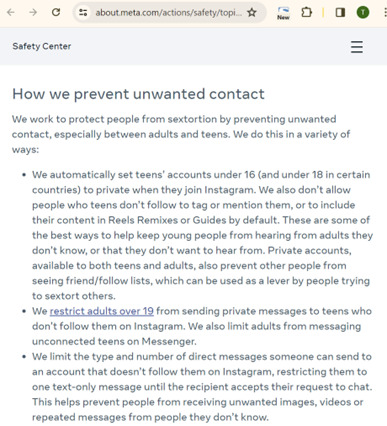
Figure 2: Meta's strategies in controlling and preventing online harassment

Figure 3: TikTok's strategy in controlling and preventing online harassment
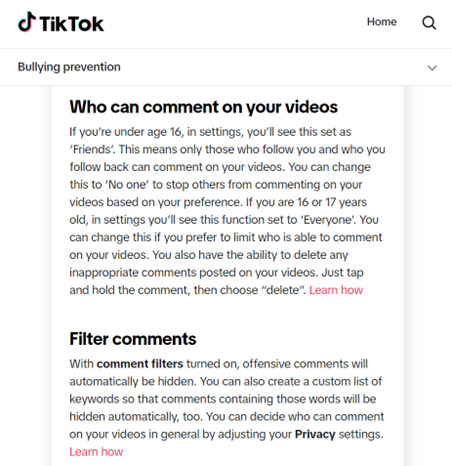
Figure 4: TikTok's strategies in controlling and preventing online harassment
ONLINE HARASSMENT MUST BE SOLVED FROM THE ROOT
Although social media platforms have used many strategies to prevent and control online harassment as mentioned above, those strategies are unbale to fully solve the issue. Schoenebeck et al. (2023, p. 4) claim that people’s behavior will not be changed after their social media accounts are banned or their inappropriate content is removed; additionally, removing content or banning users do not motivate people to not harass others in the online world.
THE SOLUTIONS FOR DEALING AND SOLVING ONLINE HARASSMENT
To truly and fully deal with online harassment, it is suggested that education, especially digital citizenship education, must be involved. The reason is that digital citizenship education teaches people to behave legally, ethically, and safely when they are appearing in the online world (Heath, 2018, p. 343). In addition, digital citizenship education also makes people become one of the three types of citizens, including “personally responsible citizens”, “participatory citizens”, and “justice-oriented citizens” (Heath, 2018, p. 345) or makes people become a citizen that has all those three characteristics. Digital citizenship education educates people on how they should behave online and in the long run, it can change their behaviors.
EXAMPLE
Thanks to digital citizenship education, some people become “participatory citizens," which refers to citizens who engage and participate in the community in order to solve social problems (Heath, 2018, p. 345). Anna Gensler (IG account: Instagranniepants) is a highlight example. As she has been harassed online and talked disrespectfully on online dating sites, as an artist and as a digital citizen, she has decided to fight against online harassment through her drawings (Figure 5). As stated in the article, “The intention of Gensler’s art is thus to ‘objectify back’, educate, name inappropriate behavior, punish perpetrators and assert herself.” (Vitis & Gilmour, 2016).

Figure 5: Anna Gensler as a participatory citizen
CONCLUSION
In conclusion, online harassment causes digitized inequality for women as it demotivates them from participating in the digital world. Although various social media platforms, such as Facebook, Instagram, and TikTok, are now putting efforts into controlling and preventing online harassment, they are still solving the surface of the issue. In order to fully solve online harassment, digital citizenship education is the most prioritized strategy.
REFERNCES
Haslop, C., O’Rourke, F., & Southern, R. (2021). #NoSnowflakes: The toleration of harassment and an emergent gender-related digital divide, in a UK student online culture. Convergence: The International Journal of Research into New Media Technologies, 27(5), 1418–1438. https://doi.org/10.1177/1354856521989270
Heath, M. K. (2018). What kind of (digital) citizen? The International Journal of Information and Learning Technology, 35(5), 342–356. https://doi.org/10.1108/ijilt-06-2018-0067
Schoenebeck, S., Lampe, C., & Triệu, P. (2023). Online Harassment: Assessing Harms and Remedies. Social Media + Society, 9(1), 1–12. https://doi.org/10.1177/20563051231157297
Vitis, L., & Gilmour, F. (2016). Dick pics on blast: A woman’s resistance to online sexual harassment using humour, art and Instagram. Crime, Media, Culture: An International Journal, 13(3), 335–355. https://doi.org/10.1177/1741659016652445
#swinburne#mda20009#week10#online harassment#participatory citizen#digital citizenship#digitized inequalities#women#social media#humour#digital space
0 notes
Text
Just spent all day facilitating a citizens’ assembly and whew, I am exhausted but so inspired. You see ordinary people, who don’t seem radical or political, coming up with ideas for free public transport and a sharing economy, calling for rewilding and housing security for all. The public are so incredible when you just give people a voice and let them know their opinion matters. I really think direct democracy could change the world, but only if it’s given the power and influence to actually inform legislation
#solarpunk#hopepunk#environmentalism#social justice#optimism#community#climate justice#citizens’ assembly#people’s assembly#direct democracy#participatory democracy#radical organising
162 notes
·
View notes
Text
The haves and the have-nots: who benefits from civic tech?
The haves and the have-nots: who benefits from civic tech?
Photo by Lewis Nguyen on Unsplash
“Civic tech” broadly refers to the use of digital technologies to support a range of citizen engagement processes. From allowing individuals to report problems to local government to enabling the crowdsourcing of national legislation, civic tech aims to promote better policies and services – while contributing to more inclusive democratic institutions. But…

View On WordPress
#change.org#citizen engagement#civic tech#civic technology#crowdsourcing#digital divide#e-petitions#participatory budgeting#petitions#political economy#political participation#responsiveness#technology
1 note
·
View note
Text
In America these days, almost any information about North Korea, be it rumor, fake news, or just plain silly, becomes fodder for the mainstream media. [...]
But when it comes to South Korea, which hosts 28,500 American ground troops and the Pentagon’s largest military base outside of North America, U.S. media coverage is, shall we say, highly selective. That was made resoundingly clear on August 14, when Seoul was the scene for the largest public demonstration in decades against the U.S. military presence in South Korea.
Amazingly, not a word about the protest appeared in the U.S. media.
That Saturday, thousands of people chanting “this land is not a U.S. war base” demonstrated against Ulchi Freedom Shield, the first large-scale military exercises between U.S. and South Korean forces since 2017. The protests were organized by the Korean Confederation of Trade Unions (KCTU), South Korea’s second-largest labor federation. They were joined by a range of progressive allies, including People’s Solidarity for Participatory Democracy (PSPD), an influential citizen’s group founded in 1994.
“At a time when military tensions on the Korean Peninsula are escalating and there is no clue for inter-Korean dialogue, we are concerned that an aggressive large-scale military exercise will exacerbate the situation,” PSPD declared. “We once again urge the US and ROK governments to suspend the ROK-US joint military exercise and make efforts to create conditions for dialogue.” At the demonstration, protesters took direct aim at the heart of U.S. policy in Korea, with signs that read “No war rehearsal, No U.S.” and “No Korea-U.S.-Japan military cooperation.”
Outside of the Korean press, the only outlets to cover this massive showing against militarism were Iran’s Press TV and China’s CGTN, which provided extensive video of the mobilization. The single print story on the march appeared in Xinhua, China’s daily wire service. Neither the New York Times or the Washington Post, which often set the pace for U.S. press coverage of Asia, deemed the demonstration newsworthy.
23 Aug 22
722 notes
·
View notes
Text
The Magic of Street-Side Trees. Beauty, Coolness, and Urban Prosperity.

The beauty, coolness, and urban prosperity brought by street-side trees.
Trees lining urban streets are integral elements of the urban landscape, serving multiple ecological roles and socio-economic functions. In general, incorporating trees along the roads in urban areas can elevate the aesthetic appeal, regulate temperatures, and foster prosperity growth. And if our goal is to enhance the role of cities in driving economic growth and fully utilizing human resources, then we must prioritize making tangible improvements to urban environments.

Trees are crucial components for creating appealing and hospitable urban environments that enhance citizens' psychological and social well-being. They play a vital role in reducing air temperature and humidity, which helps alleviate the effects of heat waves and global warming. Trees bear witness to the history, culture, and identity of cities, which they preserve and pass on to future generations. In addition to their undeniable beauty, trees are valuable allies in the fight against climate change.
They provide a range of local benefits that are often ignored beyond the global role of absorbing carbon dioxide. This article aims to increase awareness among readers about the importance of trees for cities and the planet. It seeks to motivate all of us to value, preserve, and protect the urban tree heritage through a participatory and accountable manner that involves citizens and institutions.

Street-side trees are more than just beautiful to look at. They are an essential resource for cities, providing numerous benefits to residents' health, well-being, and quality of life. In their article on Monocolo, Paolo Massi and Giulia Papaleo highlight the main advantages of trees in urban areas. La magia degli alberi lungo le strade. Bellezza, frescura e prosperità urbana

Among the benefits that trees bring to the urban environment, we can mention:
Trees perform ecological, social, and economic functions that contribute to the well-being and development of cities. They help to reduce air pollution by capturing particles, filtering harmful gases, and producing oxygen. Trees also absorb carbon from the atmosphere and store it in their wood, making them beneficial for climate change mitigation. Additionally, trees create shade, cool the air, and reduce energy consumption for cooling buildings. They prevent flooding, improve water quality, and increase biodiversity by providing shelter and food for many species. Trees enhance the urban landscape, mitigate noise, and even increase the value of properties.

Moreover, they promote physical and mental health by stimulating physical activity, reducing stress, and improving mood and concentration.
Therefore, roadside trees are a valuable resource for cities and their inhabitants. It is critical to protect, care for, and increase them through various means, such as public policies, private actions, and guaranteed maintenance over time, recognizing their fundamental role in the quality of urban life so that maintenance, which develops jobs, in particular, is 'guaranteed' over time,

Urban forestation and eco-neighborhoods.
Urban forestation refers to designing and creating green spaces in urban and peri-urban areas to incorporate nature into the landscape. It is important to both develop new green spaces and enhance existing ones.
Eco-neighborhoods serve as an example of sustainable and livable urban environments. They are designed considering the environment and the health of their residents. Sustainability principles are followed to improve the landscape and economic assets of the urban context. The design of an environmentally sustainable neighborhood aims to reduce its environmental impact during construction, throughout its life cycle, and even during decommissioning while prioritizing the comfort of its residents. These neighborhoods are built to improve people's quality of life by emphasizing energy conservation, renewable energy, environmentally friendly materials, reducing water and waste consumption, and promoting sustainable mobility. They are tangible parts of the city that contribute to the well-being of its inhabitants.
In addition, urban forestation is another example of how urban environments can be made more livable and sustainable. We can seamlessly blend nature into the urban landscape by integrating street trees, gardens, and parks. They represent elements of nature that help purify the air we breathe, capturing pollutants, storing carbon, and mitigating the climate of cities.

In summary, street-side trees are not just a decorative element but a proper green infrastructure that improves the quality of urban life. Therefore, It is vital to encourage planting, caring for, and preserving trees in urban areas, with the participation of government institutions, businesses, and residents, in order to achieve a shared vision to promote sustainable progress.
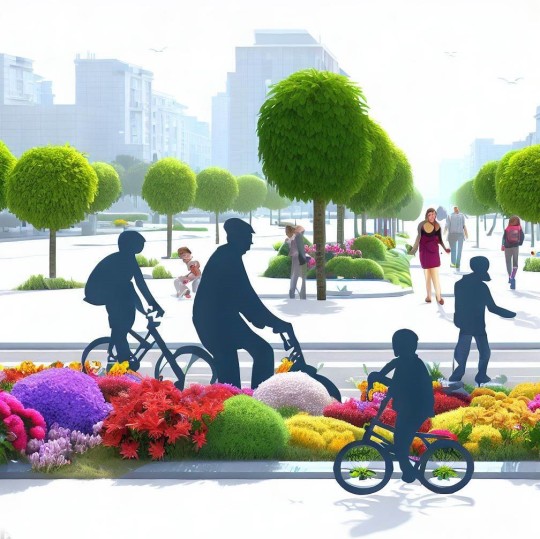
🟠 Italiano
Intro
Gli alberi sono elementi essenziali per creare paesaggi urbani attraenti e accoglienti, che favoriscono il benessere psicologico e sociale dei cittadini. contribuiscono a ridurre la temperatura e l'umidità dell'aria, mitigando gli effetti delle ondate di calore e del riscaldamento globale. Essi sono testimoni della storia, della cultura e dell'identità delle città, che conservano e trasmettono alle generazioni future. Alleati nella lotta ai cambiamenti climatici, oltre alla loro innegabile bellezza offrono una serie di benefici locali che spesso tendiamo a trascurare (al di là dei benefici globali di assorbimento dell’anidride carbonica). Questo articolo quindi ha lo scopo di sensibilizzare i lettori sull'importanza degli alberi per le città e per il pianeta, invitandoli a conoscere, apprezzare e tutelare il patrimonio arboreo urbano coinvolgendo i cittadini e le istituzioni in un processo partecipativo e responsabile.

La magia degli alberi lungo le strade. Bellezza, frescura e prosperità urbana.
Gli alberi sono una risorsa preziosa per le città, non solo per il loro contributo alla mitigazione dei cambiamenti climatici, ma anche per i molteplici benefici che apportano alla salute, al benessere e alla qualità della vita dei cittadini. In questo articolo del Monocolo gli autori Paolo Massi e Giulia Papaleo, vogliono illustrare alcuni dei principali vantaggi che gli alberi offrono alle aree urbane e alle persone che le abitano. La magia degli alberi lungo le strade. Bellezza, frescura e prosperità urbana

La magia degli alberi lungo le strade dunque non si limita alla loro estetica. Gli alberi sono elementi essenziali per il benessere e lo sviluppo delle città, in quanto svolgono funzioni ecologiche, sociali ed economiche. Tra i vantaggi che gli alberi apportano all'ambiente urbano, possiamo citare:
Riduzione dell'inquinamento atmosferico: gli alberi catturano le particelle sospese nell'aria, filtrano i gas nocivi e producono ossigeno.
Mitigazione del cambiamento climatico: gli alberi assorbono il carbonio dall'atmosfera e lo immagazzinano nel loro legno, contribuendo a ridurre l'effetto serra.
Regolazione termica: gli alberi creano ombra e rinfrescano l'aria attraverso la traspirazione, diminuendo la temperatura e il consumo energetico per il raffreddamento degli edifici.
Conservazione del suolo e dell'acqua: gli alberi riducono l'erosione del suolo, aumentano la sua capacità di infiltrazione e ritardano il deflusso delle acque piovane, prevenendo le inondazioni e migliorando la qualità dell'acqua.
Incremento della biodiversità: gli alberi offrono rifugio e cibo a molte specie animali e vegetali, arricchendo la diversità biologica delle città.
Valorizzazione del paesaggio urbano: gli alberi creano scenari naturali, armonizzano l'architettura, attenuano il rumore e aumentano il valore immobiliare delle proprietà.
Promozione della salute e del benessere umano: gli alberi favoriscono la salute fisica e mentale delle persone, stimolando l'attività fisica, riducendo lo stress, migliorando l'umore e la concentrazione.

Gli alberi e le aiuole a verde lungo le strade sono quindi una risorsa preziosa per le città e i loro abitanti. Per questo motivo, è importante proteggerli, curarli e incrementarli, attraverso politiche pubbliche e azioni private che ne riconoscano il ruolo fondamentale per la qualità della vita urbana affinché la manutenzione, che sviluppa posti di lavoro, in particolare venga 'garantita' nel tempo.
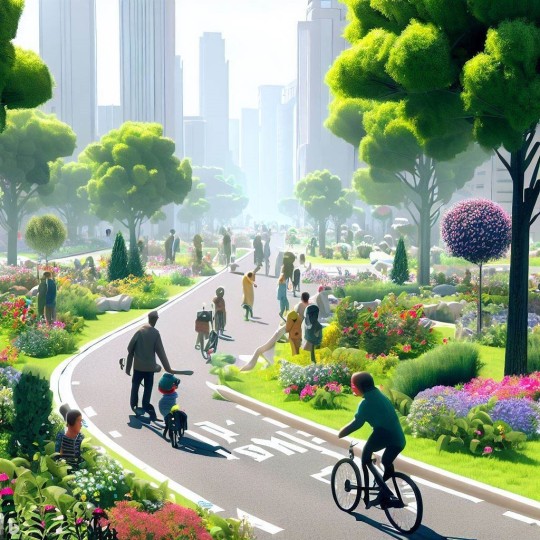
La forestazione urbana e gli ecoquartieri
Con il termine forestazione urbana si intende la progettazione e lo sviluppo di aree verdi urbane e periurbane, facendo della natura un'importante protagonista di questo paesaggio. Chiaramente è importante non solo progettare e sviluppare nuove aree verdi, ma anche rivalorizzare e riappropriarsi di quelle esistenti.
Certo! Gli ecoquartieri sono un esempio di ambienti urbani sostenibili e vivibili. Sono quartieri costruiti nel rispetto dell’equilibrio ambientale e della salute delle persone che vi abitano. Sono conformi ai principi della sostenibilità e puntano alla valorizzazione del patrimonio paesaggistico ed economico del contesto urbano in cui sono inseriti. La progettazione di un quartiere ecosostenibile punta a ridurne l’impatto ambientale: dalla fase di costruzione, al ciclo di vita, fino alla sua dismissione, senza mai dimenticare il comfort di chi lo vive. Si tratta di vere e proprie porzioni di città edificate con l’obiettivo di innalzare il livello di qualità della vita e sono realizzate ponendo l’accento su: risparmio energetico; uso delle energie rinnovabili e di materiale ecologico; riduzione del consumo di acqua e di rifiuti; promozione della mobilità sostenibile.
Inoltre, la forestazione urbana è un altro esempio di come gli ambienti urbani possono essere resi più vivibili e sostenibili. Le alberature stradali, i giardini e i parchi urbani rappresentano degli elementi di natura che contribuiscono a purificare l’aria che respiriamo, catturando sostanze inquinanti, immagazzinando carbonio e mitigando il clima delle città.
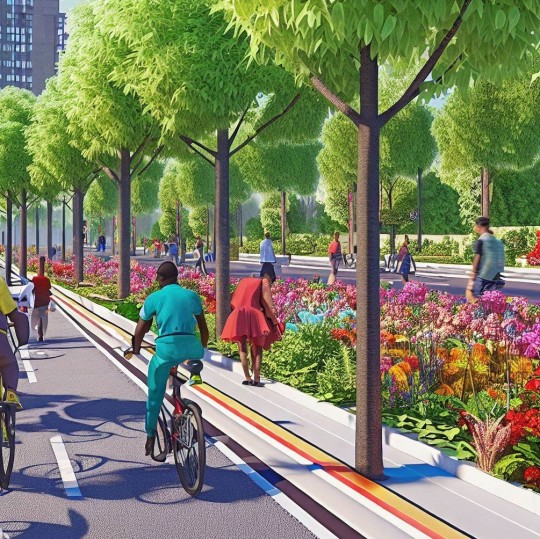
Come si può notare, gli alberi lungo le strade non sono solo un elemento decorativo, ma una vera e propria infrastruttura verde che migliora la qualità della vita urbana. Per questo motivo, è importante promuovere la piantumazione, la manutenzione e la protezione degli alberi nelle città, coinvolgendo le amministrazioni pubbliche, le imprese e i cittadini in una visione condivisa di sviluppo sostenibile.

images created by The Board Behind © 2023
More related topics on this matter you might like:
Landscape Architecture: self-reflection on improving and enhancing our cities' run-down suburbs. English /Italian
Give color to the city to celebrate the joy of living.
I appreciate your kind presence and attention on this matter. Thank you for joining us today.
⏩ The Board Behind
#the board behind#sviluppo sostenibile#urban environments#urban tree heritage#ecological restoration#social growth#economic growth#city development#well being#urban living#urban life#heat wave#heat islands#sustainable progress#social innovation
11 notes
·
View notes
Text
“Neoliberal democracy. Instead of citizens, it produces consumers. Instead of communities, it produces shopping malls. The net result is an atomized society of disengaged individuals who feel demoralized and socially powerless.
In sum, neoliberalism is the immediate and foremost enemy of genuine participatory democracy, not just in the United States but across the planet, and will be for the foreseeable future.”
― Noam Chomsky
17 notes
·
View notes
Text
Around the world today, nationalism is back—and it’s often deeply troubling. Populist politicians exploit nationalism for authoritarian, chauvinistic, racist, and xenophobic purposes, reinforcing the view that it is fundamentally reactionary and antidemocratic. But Yael (Yuli) Tamir makes a passionate argument for a very different kind of nationalism—one that revives its participatory, creative, and egalitarian virtues, answers many of the problems caused by neoliberalism and hyperglobalism, and is essential to democracy at its best. In Why Nationalism, she explains why it is more important than ever for the Left to recognize these qualities of nationalism, to reclaim it from right-wing extremists, and to redirect its power to progressive ends.
Far from being an evil force, nationalism’s power lies in its ability to empower individuals and answer basic human needs. Using it to reproduce cross-class coalitions will ensure that all citizens share essential cultural, political, and economic goods. Shifting emphasis from the global to the national and putting one’s nation first is not a way of advocating national supremacy but of redistributing responsibilities and sharing benefits in a more democratic and just way. In making the case for a liberal and democratic nationalism, Tamir also provides a compelling original account of the ways in which neoliberalism and hyperglobalism have allowed today’s Right to co-opt nationalism for its own purposes.
Provocative and hopeful, Why Nationalism is a timely and essential rethinking of a defining feature of our politics.
3 notes
·
View notes
Text
Reading This Week 2024 #4
working on catching up on reading since i was sick the week before! i think I'm gonna be using a new color for skimmed reading, so i don't mislead you into thinking I fully read more than I did. right now that color is blue
Finished:
Lost Children Archive by Valeria Luiselli
just housekeeping since I already shared my thoughts in the last post, read for the global novel
Started and Finished:
"The Pocahontas Perplex: The Image of Indian Women in American Culture" by Rayna Green
"Indian Women as Cultural Mediators" by Clara Sue Kidwell (skimmed)
"Decolonizing the Queer Native Body (and Recovering the Native Bull-Dyke): Bringing "Sexy Back" and Out of Native Studies' Closet" by Chris Finley (skimmed)
above three for my native indigenous bodies class
"The Deadly Corruption of Clinical Trials" by Carl Elliott
"Community-Centered Praxis: Toward an Alternative Non-dominative Applied Anthropology" by Merrill Singer (skimmed)
"Ethical and social dilemmas in community-based controlled trials in situations of poverty: a view from a South African project" by Nosisana Nama and Leslie Swartz (skimmed)
"The Personal is Political: Developing new subjectivities through participatory action research" by Caitlin Cahill (skimmed)
above four for my wgs foundations class, the Carl Elliott article is devasting, and a harrowing read
"Prologue," "IV. Bisclavert," and "V. Lanval" from The Lays of Marie de France with commentary and translation by Edward J. Gallagher
"Did the Middle Ages Believe in Their Miracles?" by Steven Justice (skimmed)
above two for the fantasy class i'm assisting. really liked Bisclavert as a werewolf story but there certainly is a lot of misogynistic stuff going on with the women in these stories
excerpts from Invisible Cities by Italo Calvino, translated by William Weaver: "Cities & Memory," "Cities & Desire," and "Cities & the Dead 1, 2, & 4"
read for my global novel class, cool to read part of one of those books everyone talks about
"The Fairy Way of Writing" by Joseph Addison from The Spectator No. 419
also for fantasy class
Started and Ongoing:
Gulliver's Travels by Jonathan Swift, specifically read "The Publisher to the Reader" and "A Voyage to Lilliput"
way more potty humor than i expected, and i enjoyed torturing a friend by reading some of the piss heavy sections of lilliput aloud
The Book of Disappearance by Ibtisam Azem, translated by Sinan Antoon
now this is a book i have a lot to say on (and i technically finished it the morning i'm writing this but i remain committed to how I am dividing my reading logs). i'm reading it for my global novel class. it's a book by a Palestinian author with the premise of "What if, with no warning or explanation, every Palestinian within the borders of Israel and Palestine just disappeared?" It's largely about the reaction of the state of Israel and its citizens, told from the perspective of an Israeli journalist who is reading the personal diary of his Palestinian friend.
yknow how a lot of the time when an author is writing characters that they politically disagree with, they'll end up in the realm of caricature pretty quickly, either cartoonishly out of proportion or softened in a way that shows the writer doesn't actually understand them? this book avoids that entirely and Azem is just masterful at writing Zionist characters that are damning critiques of Zionism without falling into parody. i'm really looking forward to talking about this book in class tomorrow
Ouran High School Host Club, Vol. 6 by Bisco Hatori, translated by Naomi Kokubo & Eric-Jon Rössel Waugh
and now for something completely different. just reading some good old fashioned shoujo for fun! my library has a very eclectic spread of the ohshc ebooks, so i'll have to wait to read the next volume, or skip significantly ahead (tbh. would be fine with this manga probably)
2 notes
·
View notes
Text
The Digital Frontline: Ukraine's Crowdsourcing Revolution in Warfare
In an era marked by digital transformation, Ukraine's response to Russian aggression showcases an extraordinary use of crowdsourcing in warfare. This blog post explores Ukraine's innovative approach, which leverages digital platforms to mobilize public action, document war crimes, and counter disinformation, thereby redefining the contours of modern warfare and justice.

The Rise of "e-Enemy" and Digital Witnessing
Central to Ukraine's digital arsenal is the "e-Enemy" chatbot, a brainchild of the country's Digital Ministry. This platform empowers citizens to report Russian troop movements and war crimes. Each smartphone becomes a digital witness as users upload time-stamped, geo-tagged footage, ensuring accurate documentation of enemy actions. This system of digital witnessing has turned ordinary citizens into crucial contributors to Ukraine's defense mechanism (Bergengruen 2022) (Lawler 2023).
Background:
President Volodymyr Zelensky's 2019 election was predicated on digitizing the state, culminating in the Diia app (Lawler 2023).
Diia, used by 19 million Ukrainians, facilitates digital ID access and government services, streamlining administrative processes and reducing corruption (Lawler 2023).
Adaptation During War:
Diia's features expanded to meet wartime needs with the onset of war, including evacuation assistance and property damage reporting (Lawler 2023).
The "e-Enemy" feature on Diia enables users to report Russian military movements, enhancing the military's situational awareness (Lawler 2023).
Crowdsourcing in Ukraine: A Community's Digital Armor
Ukraine's crowdsourcing strategy extends beyond the battlefield. By engaging the community in data collection, Ukraine has fostered a sense of unity and purpose among its populace. This collective effort goes beyond data accumulation; it moves towards transparency and participatory defence. Citizens document Russian offences, creating a vast archive of digital evidence. This democratizes information gathering and ensures clarity in the chaos of war (Bergengruen 2022).
The scale and systematic nature of Ukraine's efforts stand out. Over 253,000 reports of Russian military activities have been submitted via "e-Enemy", with more than 66,000 instances of property damage catalogued (Bergengruen 2022).
These reports feed into a centralized database at Ukraine's Prosecutor General's Office, categorizing war crimes and human rights violations (Bergengruen 2022).

Beyond Documentation: Tackling Misinformation
Ukraine's crowdsourcing initiatives are crucial in countering disinformation in the information warfare accompanying the physical conflict. These digital tools debunk false narratives by providing a channel for real-time, verified updates. Thus, crowdsourcing becomes not just a tool for evidence gathering but also a means to uphold truth (Bergengruen 2022) (Druziuk 2022).
Ukraine's documentation serves two purposes: providing evidence against Russian war crimes and countering Kremlin disinformation. This digital archive will be vital in preserving the factual narrative of the war (Druziuk 2022).
Legal Frontiers: Crowdsourcing and International Law
Ukraine's digital evidence collection could revolutionize international law. The array of user-submitted content – images, videos, eyewitness accounts – is building a solid case for war crimes tribunals. This innovative approach may set a new precedent in international law, recognizing the significance of open-source intelligence and citizen journalism in legal proceedings. The challenge lies in the digital nature of evidence and its admissibility under international law standards. Thus, Ukraine's efforts are to adapt and influence international legal practices. This digital mobilization raises critical questions about the traditional distinction between civilians and combatants. When civilians use technology like smartphones to aid military efforts, they potentially become active participants in military operations. This involvement could blur the lines between civilian and combatant roles, a distinction fundamental to international humanitarian law, as established by the Geneva Conventions and other legal frameworks (Bergengruen 2022) (Druziuk 2022) (Olejnik 2022).
Conclusion: Crowdsourcing as Ukraine's Beacon of Hope
In these times of adversity, Ukraine's embrace of crowdsourcing stands as a beacon of resilience and innovation, exemplifying the transformative power of technology in the realms of justice, unity, and truth. The nation's pioneering use of digital tools in warfare serves as a learning model for the global community, offering valuable insights into integrating technology in conflict resolution. Moreover, Ukraine's approach underscores the urgent need for clarity in applying international laws in this rapidly evolving digital age. As personal technology continues to reshape the battlefield, the international community must address and adapt to these challenges, ensuring that the principles of justice and sovereignty are upheld in the face of technological advancements. Thus, Ukraine's journey highlights the nation's steadfast spirit in the face of conflict and marks a significant shift in modern warfare and international law (Olejnik 2022).

https://www.reddit.com/r/ukraine/comments/xpi78b/this_was_uploaded_online_with_the_caption_we_are/?utm_source=share&utm_medium=web2x&context=3
Reflective Closing
The unfolding story of Ukraine's digital defence prompts a broader reflection on the role of technology in conflicts. Ukraine's example offers lessons for the international community on leveraging technology for justice and conflict resolution. This narrative highlights Ukraine's creative approach to warfare and emphasizes the transformative power of technology in shaping geopolitical realities. It's a testament to the enduring spirit of the Ukrainian people and their steadfast pursuit of justice and sovereignty.
References
Bergengruen, V. (2022, April 18). How Ukraine is crowdsourcing digital evidence of war crimes. Time. https://time.com/6166781/ukraine-crowdsourcing-war-crimes/
Druziuk, Y. (2022, April 19). A citizen-like chatbot allows Ukrainians to report to the government when they spot Russian troops - here’s how it works. Business Insider. https://www.businessinsider.com/ukraine-military-e-enemy-telegram-app-2022-4
Lawler, D. (2023, May 26). Ukrainians use the same app to file taxes and track Russian troops - axios. AXIOS. https://www.axios.com/2023/05/26/ukraine-diia-app-fedorov-russian-troops
Olejnik, L. (2022, June 6). Smartphones blur the line between civilian and combatant. Wired. https://www.wired.com/story/smartphones-ukraine-civilian-combatant/
2 notes
·
View notes
Text
Public Health Campaigns & Communities

The convergence of public health campaigns with social media platforms in the modern digital era has changed how people interact and perceive health-related content. Public health communications and community engagement are greatly aided by the complex interplay between our social experiences on social media and the affordances of these platforms. Using a case study to provide a thorough analysis, this essay examines the symbiotic relationship between social media, its affordances, and how communities use these platforms in the context of public health initiatives.
Public health campaigns can benefit from the special affordances offered by social media platforms. Compared to more conventional forms of communication, social networking platforms like Facebook, Instagram, WhatsApp, and Twitter have made it easier and faster to share news with a far larger audience. Because of these characteristics, it is now essential for academics to use social media to communicate their research and to produce reputable content that can be viewed by a large audience (Dong et al., 2020). These advantages are used by public health advocates and organisations to disseminate instructional materials, reach a wide audience, and encourage healthy lifestyle choices.
An effective case study demonstrating the significant influence of social media on public health efforts is the COVID-19 pandemic. Social media sites such as Twitter and Instagram have emerged as vital conduits for the dissemination of factual information, dispelling myths, and promoting preventative measures. Health officials took advantage of social media's real-time nature to interact with the public, share instructions, and offer timely information.

Social media platforms have made it easier to distribute infographics, videos, and other visually appealing content that conveys complicated medical knowledge widely. As a result of the popularity of hashtags like #MaskUp and #StayHome, there was a sense of collective commitment to public health recommendations. Social media users' interconnection facilitated the quick dissemination of information, highlighting the cooperative character of community involvement in public health initiatives.

Social media platforms function as dynamic areas where citizens participate actively in public health initiatives. With the ongoing advancement of technology and other reasons, social media is becoming an increasingly potent instrument for educating people about a variety of socially relevant issues and raising awareness of them. Social media efforts can help advance mental health. According to a study on the use of social media for health by teenagers and young adults, 25% of participants said that social media may give them helpful information (Latha et al., 2020). Users are encouraged to submit their experiences, ideas, and support for health initiatives on these participatory platforms. User-generated material is a common component of public health campaigns, empowering people to become advocates for health promotion. For example, during the COVID-19 pandemic, people promoted a sense of unity, emphasised the value of immunisation, and shared personal tales of conquering the virus. The communal exchange of personal stories aided in the de-stigmatization of health-related concerns and encouraged open dialogue among community.
Social media platforms provide public health campaigns with previously unheard-of possibilities, but they also come with difficulties and moral dilemmas. The efficiency of campaigns can be hampered by the quick dissemination of false information and the emergence of "echo chambers," when people with similar views reinforce one another's opinions. According to a recent study, bogus news spreads more quickly than actual news on Twitter. For example, polarisation on the internet might encourage the spread of false information. Users also have a propensity to gravitate towards content that supports their opinions and associate with communities that are built around a common story—a phenomenon known as echo chambers. The rise of social media echo chambers could be explained by selective exposure and confirmation bias (Cinelli et al., 2021). Promoting inclusive dialogues that reach a range of audiences and utilising tactics to guarantee information accuracy are two ways public health advocates must overcome these obstacles. For instance, during the epidemic, government health officials "took action" against 14 social media posts that spread false information about Covid-19 (Zainul, 2022).
In summary, the distinct affordances that social media platforms provide are closely linked to our social experiences in public health initiatives. The COVID-19 pandemic case study emphasises how social media may have a revolutionary impact on community participation, the dissemination of factual information, and the promotion of healthy practises. Social media platforms are dynamic hubs for information sharing and community development because of their participatory nature, which enables communities to actively participate in public health activities. Understanding and utilising social media platforms' affordances is essential for the success of public health initiatives and the welfare of communities everywhere as we continue to navigate the rapidly changing environment of digital communication.
List of References
Cinelli, M., De Francisci Morales, G., Galeazzi, A., Quattrociocchi, W., & Starnini, M. (2021). The echo chamber effect on social media. Proceedings of the National Academy of Sciences of the United States of America, 118(9). https://doi.org/10.1073/pnas.2023301118.
Dong, J., Saunders, C., Wachira, B., Thoma, B., & Chan, T. M. (2020). Social media and the modern scientist: a research primer for low- and middle-income countries. African Journal of Emergency Medicine, 10, S120–S124. https://doi.org/10.1016/j.afjem.2020.04.005.
Latha, K. R., Meena, K. S., Pravitha, M. R., Dasgupta, M., & Chaturvedi, S. K. (2020). Effective use of social media platforms for promotion of mental health awareness. Journal of Education and Health Promotion, 9(1), 124. https://doi.org/10.4103/jehp.jehp_90_20.
Sheikh, B. F., Karam, A., Botero, L. F. V., Neulat, L., Madhujan, L. R., Meléndez-Samó, L. M., Subba, U. K., Siu, O., & Giannone, Z. (n.d.). Stories of hope, resilience and inspiration during the coronavirus pandemic. https://www.apa.org. https://www.apa.org/international/global-insights/stories-pandemic.
Zainul, H. (2022, March 4). Harris Zainul. https://www.isis.org.my/2022/03/04/moh-acted-on-14-viral-fake-news-posts-for-covid-misinformation/.
2 notes
·
View notes
Text
Music Therapy and its Benefits to Senior Health At Senior Citizen Home Faridabad
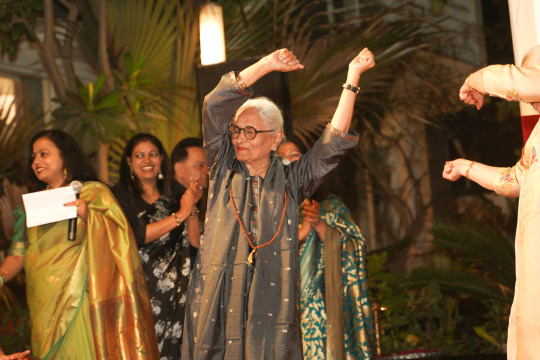
In many people's life, music has a profound and enjoyable influence. A great song may improve your day, make you feel better, and bring back fond memories. All seniors, from those who are healthy and active to those who have cognitive issues, may gain from seniors and music, making it a particularly crucial combination.
Seniors' demands for connection and mobility can be satisfactorily met by music therapy at Senior citizen home Faridabad.
Learn more about the advantages of listening to music, some typical music therapy methods, and how seniors may locate their favorite music.
What is Music Therapy for Seniors?
Seniors can participate in official or informal music therapy sessions that might include everything from listening to music to writing their own songs, improvising music or songs, or even just drumming or clapping along.
Active or receptive delivery are the two basic approaches used in music therapy. Here's how they operate:
Active Music Therapy
With the use of musical instruments, dancing, or singing, this approach is participatory. This promotes excitement and activity, both of which are good for physical wellness.
Receptive Music Therapy
With carefully chosen music, whether live or recorded, this technique promotes conscious music listening. The music chosen for seniors will frequently represent their generational makeup, culture, and shared and individual experiences.
How Can Music Help Senior Health?
According to a 2022 research published by the National Institutes of Health, seniors who listen to music report higher levels of creativity and social connection. Music can enhance the health of elders who suffer from depression and chronic health conditions.
Here are a few positive advantages of music for seniors:
Calm - Songs with distinctive instrumentation, lyrics, rhythms, and themes can ease elders into a state of relaxation. Songs have been shown to reduce heart rate and lower cortisol levels, which are connected to stress.
Communication - Seniors who are unable to speak might hum or move their hands in time to the music. When it would normally be difficult for them to do so, that might inspire them to express their emotions and share their excitement.
Memory - Seniors at Senior citizen home Faridabad who listen to music are more likely to remember words, rhythms, and patterns. The pleasant recollections of cherished persons and locations can also be evoked by well-known tunes.
Mood - Upbeat, upbeat music can help raise individuals out of sadness by assisting them in overcoming feelings of dread, helplessness, and loneliness. The ability of music to divert depressed people's attention can help them unwind and reduce tension.
Movement - Seniors at Senior citizen home Faridabad need to move and listen to music. Some music lessons may promote activity and physical fitness. This can take the form of dancing, clapping, or movement. Movement is open to everyone, including those who are sedentary.
Socialization - Music can help to overcome barriers and combat social anxiety. Seniors may join together and discover comfort and joy via music, whether it's a pastime or a planned activity.
Where Seniors Can Find Music
You may obtain music in a variety of ways, including by purchasing it from music stores, thrift shops, or used media stores, or by borrowing CDs or DVDs from the library.
Because there are already selected playlists accessible and there is some room to make new playlists, streaming apps might be the simplest method to locate music that will appeal to seniors.
Live Joyfully at a Senior Lifestyle Community
Senior citizen home Faridabad like The Golden Estate include music in their programs, including singing, dancing, and music enjoyment as well as music creation. We enable you to have a relaxed lifestyle by providing lots of activities that encourage community and communication.
2 notes
·
View notes
Text
Thoughts on Emmanuel Macron
Emmanuel Macron is a French politician serving as the President of France since 2017.

Introduction: As an observer of French politics, it is with deep concern and disappointment that I express my dissatisfaction with the leadership of Emmanuel Macron. Despite initial promises of reform, progress, and a new era of politics, Macron's tenure as President of France has been marred by numerous shortcomings and a failure to live up to the expectations set by his campaign. In this post, I will outline some key areas where Macron's leadership has fallen short, leaving many citizens disenchanted and disillusioned. During the 2022 French Presidential elections I wanted Marine Le Pen to win. In the near future. I shall do a post of support for Marine Le Pen.
Elitism and Disconnect: One of the most glaring issues with Macron's leadership is his perceived elitism and disconnect from the everyday struggles of ordinary citizens. His background in finance and his association with the wealthy elite have often overshadowed his ability to relate to and understand the challenges faced by the working class and marginalized communities. This disconnect has bred resentment and further exacerbated the societal divide.
Economic Inequality: Despite claims of economic reform, Macron's policies have failed to address the persistent issue of economic inequality in France. The burden of economic reforms, such as tax cuts for the wealthy and labor market reforms, have fallen disproportionately on the middle and lower classes, while the rich continue to benefit. This approach has widened the wealth gap and contributed to growing social unrest.
Lack of Social Welfare: Macron's presidency has been marked by a perceived lack of attention to social welfare. From the controversial pension reforms to inadequate measures to address poverty and inequality, Macron's policies have often left vulnerable groups behind. The erosion of social safety nets and the failure to adequately address pressing social issues have created a sense of neglect among those who rely on the government for support.
Authoritarian Tendencies: While presenting himself as a progressive and centrist leader, Macron has displayed authoritarian tendencies during his tenure. The heavy-handed response to protests, attempts to curtail freedom of speech, and a perceived disregard for dissenting voices have raised concerns about the erosion of democratic values and the stifling of political discourse. Macron's approach to governance has been marked by a top-down decision-making style that undermines the principles of inclusivity and participatory democracy.
Climate Change Inadequacies: Despite championing himself as a leader committed to addressing climate change, Macron's actions have fallen short of the urgent and ambitious measures needed to combat this global crisis. France's progress in reducing greenhouse gas emissions has been slow, and significant environmental concerns such as deforestation and biodiversity loss have not received the necessary attention. Macron's rhetoric on the environment has often surpassed tangible actions.
Conclusion: Emmanuel Macron's presidency has been marked by a series of disappointments and unfulfilled promises. From a perceived elitism and disconnect from ordinary citizens to a failure to address economic inequality and social welfare concerns, Macron's leadership has left many feeling neglected and disillusioned. Furthermore, his authoritarian tendencies and inadequate response to the climate crisis raise questions about his commitment to democratic principles and the well-being of future generations. France deserves a leader who can bridge divides, prioritize social justice, and genuinely address the pressing challenges of our time.
#EmmanuelMacron#FrenchPolitics#LeadershipFailures#Elitism#EconomicInequality#SocialWelfare#Authoritarianism#ClimateChange#DemocraticValues#Disillusionment#PoliticalDiscourse#today on tumblr#marine le pen#emmanuel macron#france#european union#french politics#FrenchPresident#PolicyFailures#SocialJustice#ProtestResponse#PoliticalReform#IncomeInequality#GovernmentAccountability#EnvironmentalConcerns#PublicDiscontent
2 notes
·
View notes
Text
community science in California

Community and citizen science special issue of California Agriculture (January-March 2021) Vol 75, No 1
INTRODUCTION Special issue: Community and citizen science by Ryan Meyer, Sabrina Drill, Christopher Jadallah
In this special issue of California Agriculture, we explore diverse examples of science at UC Agriculture and Natural Resources (UC ANR) that have involved participation by people not typically expected to play a role in the research process. They might be school-age youth, clientele of UC ANR advisors, volunteers in programs such as the UC Master Gardener Program or the UC California Naturalist Program, or simply interested or concerned members of the public. We refer to this idea of scientific research conducted, in whole or in part, by amateur or nonprofessional scientists as community and citizen science (CCS). There are many other terms for it (see Eitzel et al. 2017) — such as public participation in scientific research, volunteer monitoring, crowd-sourced science, or participatory action research — emanating from various natural and social science disciplines. CCS projects can take many forms, as demonstrated by the many examples throughout this special issue. They can advance scientific research and monitoring in a variety of ways, build trust among the collaborators and create opportunities for outreach, education, stewardship and mutual understanding.
The traditions of Cooperative Extension overlap significantly with CCS. Cooperative Extension was founded with a mission to “to aid in diffusing among the people of the United States useful and practical information on subjects relating to agriculture and home economics, and to encourage the application of the same” (Conglose 2000). But translating information into a particular context often requires collaboration and a two-way flow of knowledge (Cash 2001).
...
We close this introduction with a final note about terminology. We have chosen the broad umbrella term of community and citizen science both here and in the aforementioned report, while recognizing that different forms of CCS stem from a variety of different traditions (Ottinger 2017), and every term has strengths and flaws (Eitzel et al. 2017). For example, some find the word “citizen” problematic for potentially implying that only legal citizens can contribute to science (e.g., Angulo 2020). Others draw clear boundaries around “community science” as an approach driven by community knowledge and priorities, as opposed to the interests of scientists (e.g., Pandya 2019). Rather than dictate a single term, in our editorial process we have encouraged authors in this special issue to use the term that works for them and their collaborators, while being very clear about the reasoning behind that choice.
Report: Assessing community and citizen science at UC ANR The full report can be found at https://education.ucdavis.edu/ccs-cooperative-extension.
youtube
[Citizen Science Association video titled “Make Your Citizen Science Project Count: Strategies to Produce Quality Data”]
3 notes
·
View notes
Note
What do you mean by participatory methods?
Participatory methods like community mapping, include a wide range of activities that local community members can engage with to play an active and influential part in the decisions that affect their lives.
People's voices deserve to be heard in decision making, and participatory methods typically involve either Popular Education and Participatory Learning and Action. To be effective, these methods must engage all community sectors.
Popular Education involves educators as facilitators in discussions. These discussions focus on high priority concerns and seek to uncover critical issues. "From passive to questioning consciousness, and from analytical to active critical consciousness." Successful involvement of ordinary citizens in understanding, defining, and taking action to change policies as well as their own empowered behaviors for improved well-being of all community members.
Participatory Leaning and Action is an umbrella term for a variety of similar participatory models and methods in community development. Examples may include participatory rural assessment, learning assessment methods, participatory research, incorporating the use of technology, community mapping, citizen juries, etc.,
The purpose is to draw on people's wisdom in ways that strengthen their capabilities and empower them to take local, self-determined, community-driven action; to use their own skills to monitor and evaluate the action they take; and to build locally owned institutions that can become self-sustaining.
9 notes
·
View notes
Text
Oh, it's real! Thank you to anon for letting me know 😍
On Music Day, citizens and residents are urged to play music outside in their neighborhoods or in public spaces and parks. Free concerts are also organized, where musicians play for fun and not for payment.
The goal of Fête de la Musique, or Make Music Day, is to provide thousands of free concerts throughout the day. Public areas are brimming with live music and participatory music making opportunities.
15 notes
·
View notes
Text
ICT AS A PLATFORM FOR CHANGE
1.What advantages does the creation of social media offer citizens to developing countries?
In some ways, I'd like to see developing nations forego social media in favor of in-person interactions and employment. You need to be able to get together, make plans, collaborate, and aid one another in the day-to-day tasks of getting things done if you want to develop a real network, have fruitful interactions, and actually DO things.Internet and new media communications produce independent civic value, causing better trained, better informed, and politically participatory citizens in Third World countries. Globalization of new media allows developing nations the opportunity to bring global exposure to their concerns and to unite with other disparate social movements.
2.Should international policy makers and oraganizations concerned with economic development and human rights embrace social media as tools for achieving those ends?How should social media fit into the context of ICT?
They will need to. Accepting social media is accepting that regular people might have brilliant ideas. Unfortunately,falsehoods, rumors, and lies will also spread thanks to social media. It is difficult to give the general public a double-edged blade to use.Even though the power of new platforms is widely acknowledged,less is known about some of the potentially damaging effects of using them such as surveillance,censorship,intimidation,harassment,and attachs.It is horrifying to consider that the digital sphere,which offers so many possibilities for connection and collaboration,might also serve as a platform for greater repression and intolerance. Social media platforms pose a threat to many governments in the area's ability to maintain informational control.
Information and Communication Technology (hereinafter referred to as ICT) and Social Media are valuable tools for aiding communication, collaboration and enhancing communication teaching and learning skills.
#TatakNewton
2 notes
·
View notes